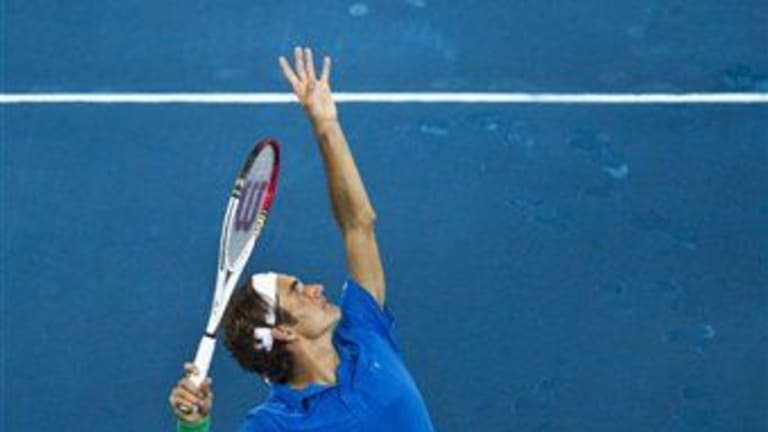“Wily veteran” is the cliché to end all clichés, but it’s hard to think of a better way to describe 30-year-old Roger Federer after his 4-6, 7-5, 7-6 (4) win over 21-year-old Milos Raonic today in Madrid. Federer, who was playing his first match after a six-week layoff, was rusty and error-prone to start. He was beaten badly in the stats department—Raonic hit 10 more winners, 46 to 36, made 11 fewer errors, 26 to 37, and cracked 14 more aces, 21 to seven. And Federer had to dig out himself out of multiple jams to stay with the young missile server for most of the evening. The Swiss had just two break points to Raonic’s eight, and the Canadian won the first 17 points in which he got his first serve in.
So how did Federer contort himself to come out on top of this one, to win the only stat that matters? He took a couple of pages from the old Pete Sampras-Paul Annacone playbook. Federer came to net 34 times, mostly on his serve, far more than normal on a clay court. It was clearly part of his game plan from the beginning, but after some time spent on the slippery blue clay, he came to rely on it more often through the middle of the match. Federer won 19 of those 34 points, but he planted a seed of doubt in his opponent’s head on returns, and he staved off one break point at 3-3 in the third set with a slyly angled backhand drop volley off of a dipping Raonic return.
Even more Samprasian was how Federer found his way through the second set. After losing the first in a flurry of errors, he immediately faced three break points in his first service game of the second; it looked like it might be quick night. But Federer saved them all with first serves—two service winners and an ace. But while had dug himself out with his serve, he would win the set with his return. The most quoted stat of the tournament had been Raonic’s winning percentage on first serve points: After 27 of them against David Nalbandian and 17 more against Federer, he had converted a none-too-shabby 100 percent. When Raonic stepped up to begin his ninth service game, at 5-6 in the second set, Federer had still won only one point on his opponent’s first ball. So what did Federer do in Raonic’s 10th service game? He won three points on his first serve and broke him for the set. Federer ended it with a little of his own flair, and a shot that Sampras rarely tried: A forehand drop that completely fooled Raonic.
Still, you don’t win a match like this without a little help at the crucial moments. Raonic might lose some sleep over three shots in particular. A routine forehand that he dropped into the net at break point at 5-5 in the second set—it was one of the first poor shots he’d hit all day. An ill-advised go-for-broke backhand down the line on another break point, at 2-2 in the third set, that he drilled into the net. And, the dagger in his own heart, a sitter forehand at 4-5 in the third-set tiebreaker that he sent wildly and nervously long. Raonic was impressive in many ways, and he was inches from his first win over any of the Top 3. His serve, aside from that one lapse, was unstoppable—love hold followed love hold through the third set, and he batted away any small signs of trouble with blistering unreturnables. For now, he remains one big point away from the next level, a point he might find a way to win next time.
As for Federer, the chance for more match play is probably as important to him as the win itself. He took something of a chance in not playing Monte Carlo and starting his clay preparation on Madrid’s blue stuff, which he kicked in disgust on more than one occasion today. As it was, with all of his net-rushing today, he may have gotten in more preparation for Wimbledon and the Olympics than he did for the French Open.
Federer was hardly at his best, but he made the shots he had to make. His first and last returns in the final-set tiebreaker stick out. At 1-1, he earned a mini-break by sliding a backhand slice low and crosscourt; Raonic couldn’t get down to dig it out, and he put his backhand into the tape—a vintage Federer play. The second memorable return, which came at match point, was a crosscourt forehand that found the opposite corner for a stunning outright winner. That one looked less like vintage Federer than it did vintage Novak Djokovic—Federer made it his own when he needed it.
Maybe, after all, there is a better way to describe Federer, who plays Richard Gasquet next, than as a "wily veteran." Call him the first Houdini of blue clay.
